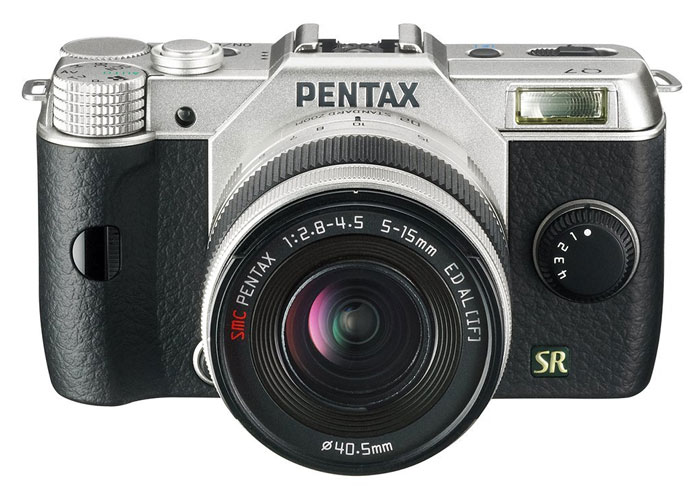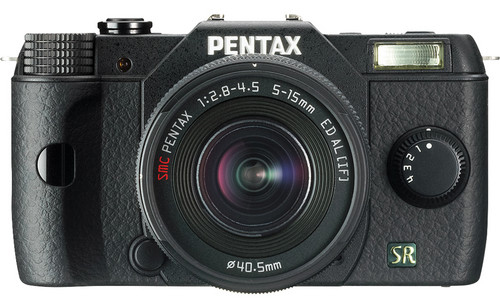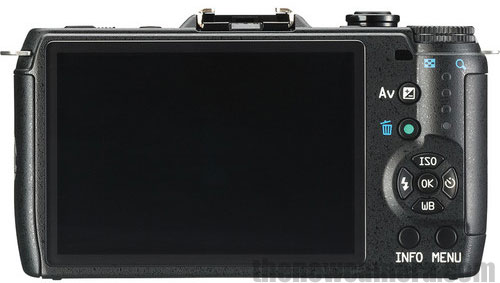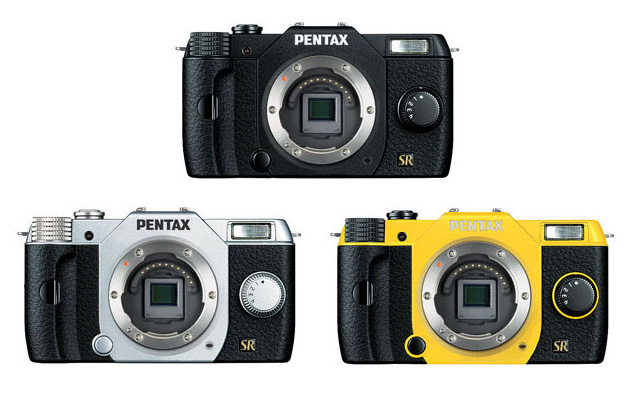Pentax Q7 features newly developed 12.4 megapixels 1/1.7-inch, back-illuminated CMOS image sensor, high-sensitivity shooting at an ISO 12800, Sensor-Shift Shake Reduction, 3″ LCD Monitor with advanced anti-reflection coating and Eye-Fi Card Compatibility.
Major Features
- 12.4MP 1/1.7″ Backlit CMOS Sensor
- Fits Pentax Q-Mount Lens System
- 3.0″ 460k-dot LCD with AR Coating
- Full 1080p HD/H.264 Video Recording
- 5 fps Burst Shooting and 1/2000s Shutter
- ISO Sensitivities up to 12800
- In-Camera Sensor-Shift Shake Reduction
- In-Camera RAW Processing
- Micro HDMI Port
- Built-in Pop-up Flash
Q7 supports both autofocus (contrast detect AF system only) and manual focus capability, Q7 also features TTL image sensor metering, segment metering, center-weighted metering, and spot metering. In addition, traditional DSLR exposure modes, such as P (Program), Av (Aperture priority), Tv (Shutter priority), and M (Manual) are available. The Q7 can record videos in 1080p Full HD resolution in the MPEG-4 AVC/H.264 format.
Pentax Q Price – (view latest price at amazon and B&H)
Pentax Q7 Press Release
PENTAX Q7
A super-compact digital interchangeable-lens camera, featuring a new extra-large image sensor for enhanced performance
PENTAX RICOH IMAGING UK LTD. is pleased to announce the launch of the PENTAX Q7 digital interchangeable-lens camera. As the flagship model in the PENTAX Q series, the Q7 is equipped with an image sensor much larger than other Q models for upgraded image quality, while retaining a super-compact, lightweight body that comfortably fits into a photographer’s hand.
The PENTAX Q7 makes digital-SLR-quality photography accessible to everyone, and thanks to a new 1/1.7-inch, back-illuminated CMOS image sensor, delivers much improved image quality. In addition, the camera also offers a host of advanced features expected in a top-of-the-range model, such as; high-sensitivity shooting, improved shake-reduction performance and effortless, user-friendly operation.
The Q7 also features an array of creative tools such as Bokeh Control and Smart Effect, which assist the photographer in easily creating personalised images.
The Q7 will be available from September. RSP TBC.
Major Features
1. Extra-large 1/1.7-inch image sensor — the largest in the Q series
Thanks to a new 1/1.7-inch, back-illuminated CMOS image sensor, the PENTAX Q7 boasts the finest image quality in the Q series. By coupling this image sensor with the state-of-the-art Q ENGINE high-speed imaging engine, the Q7 not only offers high-sensitivity shooting at an ISO 12800 and delivers beautiful images with faithful reproduction of gradation and texture, it also minimises annoying noise effectively at all ISO sensitivity levels.
Its autofocus accuracy during low-illumination shooting has also been improved, assuring pinpoint focus on the subject even at the faintest light level of EV 0. Because of its larger sensor, the angle of view for the Q7 is wider than that of its sister models, even when the same lens is mounted.* When the 02 Standard Zoom lens is mounted, for instance, the angle of view is 23mm to 69mm in the 35mm format (compared to 27.5mm to 83mm for the Q10). Likewise, when the Adapter Q for K-mount Lenses is used with the Q7, the focal length of the mounted lens is extended by approximately 4.6 times (compared to approximately 5.5 times for the Q10).
* With Q-mounted lenses, the shift in angle of view may vary depending on the lens type.
2. Outstanding operability
Thanks to the incorporation of a new Q ENGINE which provides a 10% improvement in clock frequency compared to existing engines, and optimised algorithm, the Q7 features a shortened start-up time lag of approximately one second. It also means much-improved response during shooting, such as a shortened time lag between exposures. The Quick Dial, to which the photographer can assign as many as four favourite functions, is now more versatile and functional than ever before, with the addition of AF/MF switching, focus assist ON/OFF and ND filter ON/OFF to the list of assignable functions.
3. Dependable SR mechanism
Featuring a latest gyro sensor, the Q7’s upgraded SR (Shake Reduction) mechanism compensates camera shake by as much as three shutter steps. As a result, the Q7 produces sharp, blur-free images even under conditions prone to camera shake, such as when using a telephoto lens, shooting in the dark without flash illumination, or capturing landscapes in the twilight.
4. High-quality, Full HD movie recording, even during high-sensitivity shooting
Thanks to the improvements in the image-processing algorithm, the Q7 captures beautiful Full HD movie clips (1920 x 1080 pixels, at 30 frames per second, in the H.264 recording format) with minimal noise, even during high-sensitivity recording at ISO 12800. A new interval HD movie recording function adds more creativity to visual expression. The user can also take advantage of advanced image-processing tools including the Smart Effect modes,** an array of in-body movie editing tools, and autofocus operation during movie shooting.
** The frame rate may vary when a selected Smart Effect mode requires nonstandard image processing.
5. High-resolution, wide-view 3.0-inch LCD monitor
The Q7 features a high-resolution 3.0-inch, 3:2-proportion LCD monitor with approximately 460,000 dots. The monitor has been treated with AR (Anti-Reflection) coating to offer sharp, bright images even in bright sunshine by effectively minimising glare and reflection on the screen. Since its wide-view design makes it possible to view the image from 170 degrees horizontally and vertically, the user has a clear view of the image even when facing the monitor diagonally.
6. A selection of image-processing tools to create personalised images
(1) Custom Images to add distinctive finishing touches
The Custom Image function adds a distinctive finishing touch to an image, to more faithfully express the photographer’s creative intention or reproduce the ambience of a specific scene. The user has a choice of 11 Custom Image modes, including Bleach Bypass, which produces a dramatic, movie-like finish.
(2) Digital filter function to apply artistic visual effects
The digital filter function lets the photographer apply a variety of visual effects without requiring a computer. Of the total 17 digital filters, 11 filters including Toy Camera, Invert Colour and Posterisation can be applied during the shooting of still images and movie clips, while the remaining six are applicable only during image editing. The user can even apply different filters one after another to a single image to produce more inventive visual effects.
(3) Smart Effect function for simple dial control of finishing touches
Using the Quick-Dial positioned on the camera’s front panel, the user can quickly and effortlessly add the desired finishing touch to an image, while previewing the applied effect on the LCD monitor. From nine Smart Effect modes — including Brilliant Colour for a high-saturation finish, and Cross Process for a dramatic unique-toned finish — the user can assign four favourite modes to the dial in advance.
7. Effortless Bokeh control
The Q7’s unique Bokeh control function allows the user to purposely make the subject stand out by automatically assessing the relative distance between the in-focus subject and objects in the field of view. Since this function simplifies the advanced, SLR-calibretechnique of intentional defocusing, even a first-time digital photographer can effortlessly capture high-quality images with beautifully defocused foregrounds and/or backgrounds.
8. Simple, user-friendly Auto Picture and Scene modes
The Q7 features the PENTAX-original Auto Picture mode, which automatically selects the most appropriate shooting mode from such options as Portrait, Landscape and Macro for a given subject or scene, then optimises all affecting parameters, such as shutter speed, aperture, white balance, saturation, contrast and sharpness. It also provides 21 Scene modes including Night Scene Portrait, Pet and Backlight Silhouette, allowing even an entry digital photographer to choose the best exposure mode for a complicated subject or scene with the simple choice of an icon on the LCD monitor.
9. Flexible exposure system available only with digital lens-interchangeable camera systems
The Q7’s comprehensive exposure system provides all the advantages and flexibility of a digital lens-interchangeable camera system. To accommodate user preferences and varying photographic applications, it offers a choice of four different exposure modes: the all-purpose Programmed AE (P) mode, which automatically selects an optimum combination of aperture and shutter speed; the Shutter-Priority AE (Tv), Aperture-Priority AE (Av) and manual Exposure (M) modes, which allow the photographer to more faithfully express specific creative intentions on resulting images.
10. DRII mechanism for effective dust removal
The Q7’s DR II (Dust Removal II) mechanism effectively prevents annoying dust spots from spoiling captured images, even after the user changes lenses out in the open. Like the PENTAX K-5 II and 645D digital SLR cameras, it employs a highly effective supersonic vibration mechanism, which vibrates the image sensor at high speed to shake the dust off its surface.
11. Outline of PENTAX Q7 colour-to-order service
The new PENTAX Q7 colour-to-order service allows customers to choose from 120 camera colour combinations (including three standard models). The colour-to-order service has been extremely popular as a unique, stylish way for PENTAX camera users to express individual taste in their photographic system.
When ordering a PENTAX-02 STANDARD ZOOM lens kit with a black, silver or yellow camera body, the lens will be the same colour as the camera body. The Lens Kits ordered with any other camera body colour will come with silver lenses.
12. Other features
I. Compatibility with Eye-Fi wireless LAN SD memory cards
II. High-speed continuous shooting of up to five images per second
III. HDR mode to composite a photo with extra-wide dynamic range from three images of varying exposures
IV. CTE white-balance control mode to emphasise the predominant colour of a particular scene, such as the sunset
V. Multi-exposure mode (up to nine exposures on a single image), with an auto exposure compensation function
VI. Remote control receptors on front and back panels
VII. Digital level function to check the camera’s horizontal/vertical inclination
VIII. SILKY Developer Studio 3.0 LE for PENTAX RAW-data development software (developed by Ichikawa Soft Laboratory) included; in-camera RAW-data development also available
♦ HDMI, the HDMI Logo and High-Definition Multimedia Interface are trademarks or registered trademarks of HDMI Licensing LLC.
♦ All other brands or product names are trademarks or registered trademarks of their respective companies.
♦ Designs and specifications are
Pentax Q7 Full Specification
| Body type | |
| Body type | Rangefinder-style mirrorless |
| Sensor | |
| Max resolution | 4000 x 3000 |
| Other resolutions | 4000 x 2664, 4000 x 2248, 3072 x 2304, 3072 x 2048, 3072 x 1728, 2992 x 2992, 2304 x 2304, 1920 x 1440, 1920 x 1280, 1920 x 1080, 1440 x 1440 |
| Image ratio w:h | 1:1, 4:3, 3:2, 16:9 |
| Effective pixels | 12.4 megapixels |
| Sensor photo detectors | 12.8 megapixels |
| Sensor size | 1/1.7″ (7.44 x 5.58 mm) |
| Sensor type | BSI-CMOS |
| Image | |
| White balance presets | 9 |
| Custom white balance | Yes |
| Image stabilization | Sensor-shift |
| Uncompressed format | RAW |
| JPEG quality levels | Good, Better, Best |
| File format |
|
| Optics & Focus | |
| Autofocus |
|
| Lens mount | Pentax Q |
| Focal length multiplier | 4.7× |
| Screen / viewfinder | |
| Articulated LCD | Fixed |
| Screen size | 3″ |
| Screen dots | 460,000 |
| Touch screen | No |
| Screen type | TFT color LCD monitor, wide angle viewing, AR coating |
| Live view | Yes |
| Viewfinder type | Optical (optional) |
| Photography features | |
| Minimum shutter speed | 30 sec |
| Maximum shutter speed | 1/2000 sec |
| Exposure modes |
|
| Scene modes |
|
| Built-in flash | Yes (Built-in retractable P-TTL flash) |
| Flash range | 4.9 m (ISO100/m) |
| External flash | Yes |
| Flash modes | P-TTL, Red-eye Reduction, Slow-speed Sync, Trailing Curtain Sync |
| Flash X sync speed | 1/2000 sec |
| Drive modes |
|
| Self-timer | Yes (12 sec, 2 sec) |
| Metering modes |
|
| Exposure compensation | ±3 (at 1/3 EV steps) |
| AE Bracketing | (3 frames at 1/3 EV steps) |
| Videography features | |
| Format |
|
| Microphone | Mono |
| Speaker | Mono |
| Resolutions | FullHD(1920×1080, 30fps/25fps/24fps), HD(1280×720,16:9,30fps/25fps/24fps), VGA(640×480,4:3,30fps/25fps/24fps) |
| Videography notes | MOV MPEG–4 AVC/H.264 (.mov) |
| Storage | |
| Storage types | SD, SDHC, SDXC and Eye-Fi Card |
| Connectivity | |
| USB | USB 2.0 (480 Mbit/sec) |
| HDMI | Yes (HDMI output terminal (Type D)) |
| Wireless | Eye-Fi Connected |
| Remote control | Yes (Remote Control O-RC1, Remote F) |
| Physical | |
| Battery | Battery Pack |
| Battery description | Rechargeable Lithium-ion Battery D-LI68 |
| Battery Life (CIPA) | 250 |
| Weight (inc. batteries) | 200 g (0.44 lb / 7.05 oz) |
| Dimensions | 102 x 58 x 34 mm (4.02 x 2.28 x 1.34″) |
| Other features | |
| Timelapse recording | Yes (3 sec. to 24 hr., Start Interval setting: immediately from the set time. Number of shots: up to 999 images) |
| GPS | None |











